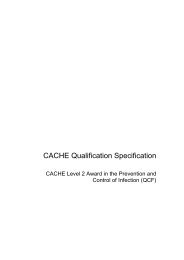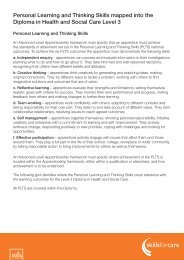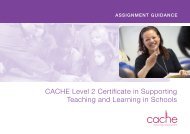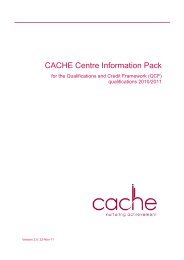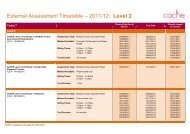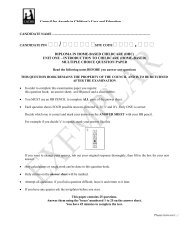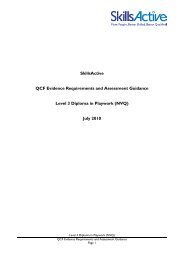CACHE Key Skills Learner Handbook
CACHE Key Skills Learner Handbook
CACHE Key Skills Learner Handbook
Create successful ePaper yourself
Turn your PDF publications into a flip-book with our unique Google optimized e-Paper software.
<strong>CACHE</strong> <strong>Key</strong> <strong>Skills</strong> <strong>Learner</strong> <strong>Handbook</strong><br />
Application of Number<br />
Communication<br />
Information and Communication Technology<br />
To be read in conjunction with the 2004 <strong>Key</strong> <strong>Skills</strong> qualifications standards and guidance<br />
published by QCDA<br />
http://www.qcda.gov.uk/resources/assets/8929_qca04_1294.pdf
<strong>CACHE</strong> <strong>Key</strong> <strong>Skills</strong><br />
<strong>CACHE</strong> © Copyright 2011 All rights reserved worldwide.<br />
Reproduction by approved <strong>CACHE</strong> centres is permissible for internal use under the following conditions:<br />
<strong>CACHE</strong> has provided this <strong>Learner</strong> <strong>Handbook</strong> in Microsoft Word format to enable its Centres to use its<br />
content more flexibly within their own course materials. You may copy and paste any material from this<br />
document; however, <strong>CACHE</strong> does not accept any liability for any incomplete or inaccurate copying and<br />
subsequent use of this information. The use of PDF versions of our support materials on the <strong>CACHE</strong><br />
website will ensure that correct and up-to-date information is provided to learners.<br />
All photographs appearing in this handbook have a signed parental release form and are the exclusive<br />
property of <strong>CACHE</strong>. They are protected under the copyright law and can not be reproduced, copied or<br />
manipulated in any form. This includes the use of any image or part of an image in individual or group<br />
projects and assessment materials.<br />
Published in Great Britain by <strong>CACHE</strong><br />
First edition 2011<br />
Book code N/A<br />
Publication date<br />
November 2011<br />
Publisher<br />
Council for Awards in Care, Health and Education<br />
Apex House<br />
81 Camp Road<br />
St Albans<br />
Hertfordshire<br />
AL1 5GB<br />
Telephone: 0845 347 2123<br />
Registered Company No: 2887166<br />
Registered Charity No: 1036232<br />
© <strong>CACHE</strong> 2011 Version 1.0 2
<strong>Learner</strong> <strong>Handbook</strong><br />
Contents<br />
Information for learners about the recording of portfolio evidence for each <strong>Key</strong> Skill<br />
before you start 4<br />
What is a portfolio? 4<br />
What <strong>CACHE</strong> paperwork has to be completed? 4<br />
Who is responsible for the Unit Portfolio Assessment Record (UPAR)? 5<br />
What should be included in my portfolio? 5<br />
What should not be in my portfolio? 6<br />
Completing my portfolio 6<br />
Application of Number – Level 1 7<br />
Application of Number – Level 2 9<br />
Application of Number – Level 3 11<br />
Communication – Level 1 13<br />
Communication – Level 2 15<br />
Communication – Level 3 17<br />
Information and Communication Technology - Level 1 19<br />
Information and Communication Technology - Level 2 21<br />
Information and Communication Technology - Level 3 23<br />
© <strong>CACHE</strong> 2011 Version 1.0 3
<strong>CACHE</strong> <strong>Key</strong> <strong>Skills</strong><br />
Information for learners about the recording of portfolio<br />
evidence for each <strong>Key</strong> Skill before you start<br />
In order to put together your portfolio of evidence, both you and your assessor must understand<br />
the specifications for the <strong>Key</strong> <strong>Skills</strong> at the level which you are studying. It is important that you<br />
have a copy of the appropriate <strong>Key</strong> Skill standards document published by QCDA. You should be<br />
given this by your Centre. This details what you need to know to build portfolio evidence and what<br />
evidence you must include in your portfolio.<br />
In addition to your portfolio you must also complete an external element in order to gain a<br />
certificate. There are tests for Application of Number, Communication and ICT. Certain learners<br />
may be exempt from the tests if they have already achieved an appropriate level in other<br />
examinations. Centres will be able to check this for you.<br />
What is a portfolio?<br />
A portfolio is a way of gathering the evidence that you have collected to show that you<br />
understand the <strong>Key</strong> Skill that you are working towards. As most of the evidence that you collect<br />
will probably be paper based it is sensible to keep your evidence in an A4 folder. If you have used<br />
work that you have completed in your vocational qualification as evidence for <strong>Key</strong> <strong>Skills</strong> it may be<br />
sensible to keep it there rather than in a <strong>Key</strong> <strong>Skills</strong> portfolio. Your assessor will help you make the<br />
decision.<br />
QCDA have produced a series of example portfolios for each <strong>Key</strong> Skill at Levels 1, 2 and 3 which<br />
can be found at www.qcda.gov.uk/resources. These give an indication of the amount of evidence<br />
that a portfolio could include, and more importantly, give a clear indication of the level that the<br />
evidence should meet. Your assessor will have looked at these in detail and will be able to help<br />
you produce the right amount of appropriate evidence for your portfolio.<br />
What <strong>CACHE</strong> paperwork has to be completed?<br />
There are two forms that are provided by <strong>CACHE</strong> that have to be completed for each <strong>Key</strong> Skill<br />
that you are undertaking, even if you have the same assessor for more than one <strong>Key</strong> Skill.<br />
These are included in this document and can be photocopied for <strong>CACHE</strong> registered learners in<br />
<strong>CACHE</strong> approved Centres.<br />
The first is the Unit Portfolio Assessment Record. All of the evidence for a <strong>Key</strong> Skill, as shown in<br />
the QCDA <strong>Key</strong> Skill standards, must be included in your portfolio and recorded on the Unit<br />
Portfolio Assessment Record (UPAR) for that <strong>Key</strong> Skill. By each element of the skill there is a box<br />
for the portfolio evidence location. Enter the location i.e. page number, where that piece of<br />
evidence can be found. The evidence may be located in a separate file if you have used the<br />
same piece of evidence more than once – for example a piece of word processed writing may<br />
well provide evidence for communication, ICT and your main qualification. There is nothing wrong<br />
with this provided that it meets the assessment criteria for each qualification and the evidence is<br />
available for assessment and quality assurance for each qualification or <strong>Key</strong> Skill.<br />
The UPAR is used to record your evidence when it has been completed and assessed. There is<br />
space on this form for the assessor to give comments and examples of how they have reached<br />
© <strong>CACHE</strong> 2011 Version 1.0 4
<strong>Learner</strong> <strong>Handbook</strong><br />
their assessment decision. Once they are satisfied that you have provided evidence that meets<br />
the criteria for the whole <strong>Key</strong> Skill they will sign the UPAR in the space provided. You will need a<br />
different UPAR for each <strong>Key</strong> Skill that you are working towards. Each UPAR should be kept at the<br />
beginning of the evidence for that <strong>Key</strong> Skill.<br />
The second sheet is the Unit Signature Sheet for Portfolio Evidence. It gathers together all the<br />
information that relates to the learner, Centre and the assessment process. It can be completed<br />
by anyone, but must be signed by the learner and assessor.<br />
It also has a space for the date you passed the test, or the proxy qualification that you are<br />
claiming. There is also space for the internal and external quality assurers to sign if they have<br />
sampled your portfolio.<br />
Who is responsible for the Unit Portfolio Assessment<br />
Record (UPAR)?<br />
It is your responsibility to ensure that the UPAR is completed and kept with your portfolio. It is the<br />
assessor’s responsibility to ensure that the comments section has been completed and the<br />
evidence fully assessed and signed off by both assessor and learner before putting the portfolio<br />
forward for internal and external quality assurance. It is the quality assurer’s responsibility to sign<br />
if they have sampled the portfolio.<br />
What should be included in my portfolio?<br />
Your portfolio is evidence of how you have met the standards of the <strong>Key</strong> Skill. Each learner will<br />
meet this in a different way. Your assessor should support you as you gather suitable evidence.<br />
However, your portfolio must include:<br />
• the completed Unit Signature Sheet for Portfolio Evidence, signed appropriately<br />
• the completed Unit Portfolio Assessment Record, signed by your assessor<br />
• evidence referred to in the UPAR<br />
• evidence of a qualification if you are claiming a proxy exemption from the test.<br />
In addition you may wish to include:<br />
• personal details and details of how you have met the standards<br />
• a contents page<br />
• a copy of the standards for the <strong>Key</strong> Skill<br />
• self-evaluation and peer feedback<br />
• copies of source documents or information<br />
• a computer disc of work that you have done on a computer<br />
• any other information that is referred to on your UPAR.<br />
© <strong>CACHE</strong> 2011 Version 1.0 5
<strong>CACHE</strong> <strong>Key</strong> <strong>Skills</strong><br />
What should not be in my portfolio?<br />
The portfolio is evidence of how you have met the standards for Part B. In order to produce this<br />
you will have spent a lot of time and effort developing the knowledge and understanding detailed<br />
in Part A of the standards. This is good work, but should not be included in your portfolio. Other<br />
things that it would be inappropriate to include in your portfolio are:<br />
• practice test papers<br />
• drafts of work, unless they have been include to show ‘development’ in ICT<br />
• excessive internet printouts – you can provide evidence of an internet search without<br />
including a printout of every site you found<br />
• excessive evidence – if the UPAR says the evidence requirement is for two different<br />
types of document, you should only include two types of document. However, you should<br />
make sure that the two documents meet all the requirements.<br />
Completing my portfolio<br />
When you have completed all the evidence and put it together in you portfolio, check that the<br />
evidence is easy to find – quality assurers may just want to look at part of your portfolio – and you<br />
have:<br />
• a portfolio evidence location for every element detailed on the UPAR<br />
• your signature on the Unit Signature Sheet<br />
• your assessor’s signature on the Unit Signature Sheet and the UPAR<br />
• your signature on every piece of work.<br />
All Unit Signature Sheets, UPARs and assessment records must be completed in ink and signed<br />
and dated. Corrections may only be made by using a single line through the text to be amended.<br />
The use of any correcting materials, such as correcting fluid, is not permitted.<br />
By signing the evidence in the portfolio, you are confirming that the work is yours. By signing the<br />
evidence in the portfolio, your assessor is confirming that the work is yours and it meets the<br />
standards that it has been assessed against. By signing, the assessor is confirming that in their<br />
professional judgement, you are competent in the <strong>Key</strong> Skill at that level.<br />
© <strong>CACHE</strong> 2011 Version 1.0 6
Application of Number – Level 1<br />
Unit Portfolio Assessment Record<br />
Application of Number – Level 1<br />
<strong>Learner</strong> name:<br />
<strong>CACHE</strong> PIN:<br />
<strong>CACHE</strong> Centre no:<br />
ULN:<br />
Part B - The learner must:<br />
N1.1 Interpret information from two<br />
different sources. At least one source<br />
must include a table, chart, graph or<br />
diagram.<br />
1.1.1 Obtain the information you need to meet<br />
the purpose of your task.<br />
Portfolio Evidence<br />
Location<br />
Assessor comments and<br />
examples<br />
1.1.2 Identify suitable calculations to get the<br />
results you need.<br />
N1.2 Carry out and check calculations to<br />
do with:<br />
a) amounts or sizes<br />
b) scales or proportions<br />
c) handling statistics.<br />
1.2.1 Carry out calculations to the level of<br />
accuracy you have been given.<br />
a)<br />
b)<br />
c)<br />
1.2.2 Check your result makes sense.<br />
N1.3 Interpret the results of your<br />
calculations and present your<br />
findings – in two different ways using<br />
charts or diagrams.<br />
1.3.1 Choose suitable ways to present your<br />
findings.<br />
1.3.2 Use more than one way of presenting<br />
your findings.<br />
1.3.3 Present your findings clearly using a<br />
chart or diagram.<br />
1.3.4 Describe what your results tell you.<br />
© <strong>CACHE</strong> 2011 Version 1.0 7
Application of Number – Level 1<br />
Unit Signature Sheet for Portfolio Evidence<br />
<strong>Learner</strong> declaration of authenticity:<br />
I confirm that competence has been demonstrated in all portfolio requirements of this unit through<br />
agreed portfolio assessment procedures. I am satisfied with the way the assessment(s) was conducted<br />
and its outcome.<br />
<strong>Learner</strong> signature:<br />
Date:<br />
Assessor sign off of <strong>Key</strong> Skill: Application of Number Level 1<br />
I confirm that the learner has demonstrated competence in all the elements of this unit through the<br />
agreed portfolio assessment procedures.<br />
Assessor name:<br />
Signature:<br />
Date:<br />
Language of Assessment (if other than English):<br />
Proxy Exemption:<br />
All learners are also required to pass the external assessment for this unit in order to gain the unit,<br />
unless they are exempt because of a proxy qualification. A full and current list of proxy exemptions is<br />
available in the apprenticeship section of the <strong>CACHE</strong> website and on <strong>CACHE</strong>Zone.<br />
Test Pass Date:<br />
Proxy Qualification:<br />
Proxy Qualification Date:<br />
Internal/External Quality Assurance:<br />
Please tick the appropriate box<br />
Has the unit been sampled? Yes No<br />
Internal Quality Assurer Name:<br />
Internal Quality Assurer Signature:<br />
Date:<br />
External Quality Assurer Name:<br />
External Quality Assurer Signature:<br />
Date:<br />
© <strong>CACHE</strong> 2011 Version 1.0 8
Application of Number – Level 2<br />
Unit Portfolio Assessment Record<br />
Application of Number – Level 2<br />
<strong>Learner</strong> name:<br />
<strong>CACHE</strong> PIN:<br />
<strong>CACHE</strong> Centre no:<br />
ULN:<br />
Part B - Carrying out at least one<br />
activity that includes tasks for N2.1,<br />
N2.2 & N2.3, the learner must:<br />
Use two different sources which include<br />
material containing a graph or chart (N2.1).<br />
Do calculations for a, b, c and d (N2.2).<br />
Present findings in two different ways using<br />
charts, graphs or diagrams (N2.3).<br />
N2.1 Interpret information from a suitable<br />
source.<br />
2.1.1 Choose how to get the information you<br />
need to meet the purpose of your<br />
activity.<br />
2.1.2 Obtain relevant information.<br />
2.1.3 Choose appropriate methods to get the<br />
results you need.<br />
N2.2 Use your information to carry out<br />
calculations to do with:<br />
a) amounts or sizes<br />
b) scales or proportions<br />
c) handling statistics<br />
d) using formulae.<br />
2.2.1 Carry out calculations, clearly showing<br />
your methods and levels of accuracy.<br />
2.2.2 Check your methods to identify and<br />
correct any errors, and make sure your<br />
results make sense.<br />
N2.3 Interpret the results of your<br />
calculations and present your<br />
findings – in two different ways using<br />
charts or diagrams.<br />
2.3.1 Select effective ways to present your<br />
findings.<br />
2.3.2 Present your findings clearly using a<br />
chart, graph or diagram and describe<br />
your methods.<br />
2.3.3 Use more than one way of presenting<br />
your findings.<br />
2.3.4 Describe what your results tell you and<br />
how they meet your purpose.<br />
Portfolio Evidence<br />
Location<br />
a)<br />
b)<br />
c)<br />
d)<br />
Assessor comments and<br />
examples<br />
© <strong>CACHE</strong> 2011 Version 1.0 9
Application of Number – Level 2<br />
Unit Signature Sheet for Portfolio Evidence<br />
<strong>Learner</strong> declaration of authenticity:<br />
I confirm that competence has been demonstrated in all portfolio requirements of this unit through<br />
agreed portfolio assessment procedures. I am satisfied with the way the assessment(s) was conducted<br />
and its outcome.<br />
<strong>Learner</strong> signature:<br />
Date:<br />
Assessor sign off of <strong>Key</strong> Skill: Application of Number – Level 2<br />
I confirm that the learner has demonstrated competence in all the elements of this unit through the<br />
agreed portfolio assessment procedures.<br />
Assessor name:<br />
Signature:<br />
Date:<br />
Language of Assessment (if other than English):<br />
Proxy Exemption:<br />
All learners are also required to pass the external assessment for this unit in order to gain the unit,<br />
unless they are exempt because of a proxy qualification. A full and current list of proxy exemptions is<br />
available in the apprenticeship section of the <strong>CACHE</strong> website and on <strong>CACHE</strong>Zone.<br />
Test Pass Date:<br />
Proxy Qualification:<br />
Proxy Qualification Date:<br />
Internal/External Quality Assurance:<br />
Please tick the appropriate box<br />
Has the unit been sampled? Yes No<br />
Internal Quality Assurer Name:<br />
Internal Quality Assurer Signature:<br />
Date:<br />
External Quality Assurer Name:<br />
External Quality Assurer Signature:<br />
Date:<br />
© <strong>CACHE</strong> 2011 Version 1.0 10
Application of Number – Level 3<br />
Unit Portfolio Assessment Record<br />
Application of Number – Level 3<br />
<strong>Learner</strong> name:<br />
<strong>CACHE</strong> PIN:<br />
<strong>CACHE</strong> Centre no:<br />
ULN:<br />
Part B - The learner must carry out<br />
one or more activities that include<br />
tasks for N3.1, N3.2 & N3.3. Overall,<br />
through one or more activity, the<br />
learner must:<br />
Use two different types of sources, including a<br />
large data set i.e. over 50 items (N3.1).<br />
Carry out calculations to do with a, b, c and d<br />
(N3.2).<br />
Present findings in two different ways using<br />
charts, graphs or diagrams (N3.3).<br />
N3.1 Plan an activity and get relevant<br />
information from relevant sources.<br />
3.1.1 Plan how to get and use the information<br />
needed to meet the purpose of your<br />
activity.<br />
3.1.2 Obtain the relevant information.<br />
3.1.3 Choose appropriate methods to get the<br />
results you need and justify your choice.<br />
N3.2 Use your information to carry out<br />
multi-stage calculations to do with:<br />
a) amounts or sizes<br />
b) scales or proportions<br />
c) handling statistics<br />
d) using formulae.<br />
3.2.1 Carry out calculations, to appropriate<br />
levels of accuracy, clearly showing your<br />
methods.<br />
3.2.2 Check methods and results to help<br />
ensure that errors are found and<br />
corrected.<br />
N3.3 Interpret the results of your<br />
calculations, present your findings<br />
and justify your methods.<br />
3.3.1 Select appropriate methods of<br />
presentation and justify your choice.<br />
3.3.2 Present your findings effectively.<br />
3.3.3 Describe what your results tell you and<br />
whether they meet your purpose.<br />
Portfolio<br />
Evidence<br />
Location<br />
a)<br />
b)<br />
c)<br />
d)<br />
Assessor comments and<br />
examples<br />
© <strong>CACHE</strong> 2011 Version 1.0 11
Application of Number – Level 3<br />
Unit Signature Sheet for Portfolio Evidence<br />
<strong>Learner</strong> declaration of authenticity:<br />
I confirm that competence has been demonstrated in all portfolio requirements of this unit through<br />
agreed portfolio assessment procedures. I am satisfied with the way the assessment(s) was conducted<br />
and its outcome.<br />
<strong>Learner</strong> signature:<br />
Date:<br />
Assessor sign off of <strong>Key</strong> Skill: Application of Number – Level 3<br />
I confirm that the learner has demonstrated competence in all the elements of this unit through the<br />
agreed portfolio assessment procedures.<br />
Assessor name:<br />
Signature:<br />
Date:<br />
Language of Assessment (if other than English):<br />
Proxy Exemption:<br />
All learners are also required to pass the external assessment for this unit in order to gain the unit,<br />
unless they are exempt because of a proxy qualification. A full and current list of proxy exemptions is<br />
available in the apprenticeship section of the <strong>CACHE</strong> website and on <strong>CACHE</strong>Zone.<br />
Test Pass Date:<br />
Proxy Qualification:<br />
Proxy Qualification Date:<br />
Internal/External Quality Assurance:<br />
Please tick the appropriate box<br />
Has the unit been sampled? Yes No<br />
Internal Quality Assurer Name:<br />
Internal Quality Assurer Signature:<br />
Date:<br />
External Quality Assurer Name:<br />
External Quality Assurer Signature:<br />
Date:<br />
© <strong>CACHE</strong> 2011 Version 1.0 12
Communication – Level 1<br />
Unit Portfolio Assessment Record<br />
Communication – Level 1<br />
<strong>Learner</strong> name:<br />
<strong>CACHE</strong> PIN:<br />
<strong>CACHE</strong> Centre no:<br />
ULN:<br />
Part B - The learner must:<br />
C1.1 Take part in either a one-to-one<br />
discussion or a group discussion.<br />
Portfolio Evidence<br />
Location<br />
Assessor comments and<br />
examples<br />
1.1.1 Provide information that is relevant to<br />
the subject and purpose of the<br />
discussion.<br />
1.1.2 Communicate clearly in a way that suits<br />
the situation and respond appropriately<br />
to others.<br />
C1.2 Read and obtain information from at<br />
least one document.<br />
1.2.1 Read relevant material.<br />
1.2.2 Identify accurately the main points and<br />
ideas.<br />
1.2.3 Use the information to suit your purpose.<br />
C1.3 Write two different types of<br />
documents.<br />
1.3.1 Present relevant information in a format<br />
that suits your purpose.<br />
1.3.2 Spell, punctuate and use grammar<br />
accurately.<br />
1.3.3 Make your meaning clear.<br />
Use at least one image either to obtain<br />
information or to convey information.<br />
© <strong>CACHE</strong> 2011 Version 1.0 13
Communication – Level 1<br />
Unit Signature Sheet for Portfolio Evidence<br />
<strong>Learner</strong> declaration of authenticity:<br />
I confirm that competence has been demonstrated in all portfolio requirements of this unit through<br />
agreed portfolio assessment procedures. I am satisfied with the way the assessment(s) was conducted<br />
and its outcome.<br />
<strong>Learner</strong> signature:<br />
Date:<br />
Assessor sign off of <strong>Key</strong> Skill: Communication – Level 1<br />
I confirm that the learner has demonstrated competence in all the elements of this unit through the<br />
agreed portfolio assessment procedures.<br />
Assessor name:<br />
Signature:<br />
Date:<br />
Language of Assessment (if other than English):<br />
Proxy Exemption:<br />
All learners are also required to pass the external assessment for this unit in order to gain the unit,<br />
unless they are exempt because of a proxy qualification. A full and current list of proxy exemptions is<br />
available in the apprenticeship section of the <strong>CACHE</strong> website and on <strong>CACHE</strong>Zone.<br />
Test Pass Date:<br />
Proxy Qualification:<br />
Proxy Qualification Date:<br />
Internal/External Quality Assurance:<br />
Please tick the appropriate box<br />
Has the unit been sampled? Yes No<br />
Internal Quality Assurer Name:<br />
Internal Quality Assurer Signature:<br />
Date:<br />
External Quality Assurer Name:<br />
External Quality Assurer Signature:<br />
Date:<br />
© <strong>CACHE</strong> 2011 Version 1.0 14
Communication – Level 2<br />
Unit Portfolio Assessment Record<br />
Communication – Level 2<br />
<strong>Learner</strong> name:<br />
<strong>CACHE</strong> PIN:<br />
<strong>CACHE</strong> Centre no:<br />
ULN:<br />
Part B - The learner must:<br />
C2.1a Take part in a group discussion.<br />
2.1a.1 Make clear and relevant contributions<br />
in a way that suits your purpose and<br />
situation.<br />
2.1a.2 Respond appropriately to others.<br />
2.1a.3 Help to move the discussion forward.<br />
C2.1b Give a talk of at least four minutes.<br />
2.1b.1 Speak clearly in a way that suits your<br />
subject, purpose and situation.<br />
2.1b.2 Keep to the subject and structure your<br />
talk to help listeners follow what you<br />
are saying.<br />
2.1b.3 Use appropriate ways to support your<br />
main points.<br />
C2.2 Read and summarise information<br />
from at least two documents about<br />
the same subject. Each document<br />
must be a minimum of 500 words<br />
long.<br />
2.2.1 Select and read relevant documents.<br />
2.2.2 Identify accurately the main points, ideas<br />
and lines of reasoning.<br />
2.2.3 Summarise the information to suit your<br />
purpose.<br />
C2.3 Write two different types of<br />
documents each one giving different<br />
information. One document must be<br />
at least 500 words long.<br />
2.3.1 Present relevant information in a format<br />
that suits your purpose.<br />
2.3.2 Use a structure and style of writing to<br />
suit your purpose.<br />
2.3.3 Spell, punctuate and use grammar<br />
accurately.<br />
2.3.4 Make your meaning clear.<br />
Use at least one image either to obtain<br />
information or to convey information.<br />
Portfolio Evidence<br />
Location<br />
Assessor comments and<br />
examples<br />
© <strong>CACHE</strong> 2011 Version 1.0 15
Communication – Level 2<br />
Unit Signature Sheet for Portfolio Evidence<br />
<strong>Learner</strong> declaration of authenticity:<br />
I confirm that competence has been demonstrated in all portfolio requirements of this unit through<br />
agreed portfolio assessment procedures. I am satisfied with the way the assessment(s) was conducted<br />
and its outcome.<br />
<strong>Learner</strong> signature:<br />
Date:<br />
Assessor sign off of <strong>Key</strong> Skill: Communication – Level 2<br />
I confirm that the learner has demonstrated competence in all the elements of this unit through the<br />
agreed portfolio assessment procedures.<br />
Assessor name:<br />
Signature:<br />
Date:<br />
Language of Assessment (if other than English):<br />
Proxy Exemption:<br />
All learners are also required to pass the external assessment for this unit in order to gain the unit,<br />
unless they are exempt because of a proxy qualification. A full and current list of proxy exemptions is<br />
available in the apprenticeship section of the <strong>CACHE</strong> website and on <strong>CACHE</strong>Zone.<br />
Test Pass Date:<br />
Proxy Qualification:<br />
Proxy Qualification Date:<br />
Internal/External Quality Assurance:<br />
Please tick the appropriate box<br />
Has the unit been sampled? Yes No<br />
Internal Quality Assurer Name:<br />
Internal Quality Assurer Signature:<br />
Date:<br />
External Quality Assurer Name:<br />
External Quality Assurer Signature:<br />
Date:<br />
© <strong>CACHE</strong> 2011 Version 1.0 16
Communication – Level 3<br />
Unit Portfolio Assessment Record<br />
Communication – Level 3<br />
<strong>Learner</strong> name:<br />
<strong>CACHE</strong> PIN:<br />
<strong>CACHE</strong> Centre no:<br />
ULN:<br />
Part B - The learner must:<br />
C3.1a Take part in a group discussion.<br />
3.1a.1 Make clear and relevant contributions in a way<br />
that suits your purpose and situation.<br />
3.1a.2 Respond sensitively to others, and develop<br />
points and ideas.<br />
3.1a.3 Use an image or other support material to<br />
support or enhance what you are saying.<br />
C3.1b Make a formal presentation of at least eight<br />
minutes using an image or other support<br />
material.<br />
3.1b.1 Speak clearly and adapt your style of<br />
presentation to suit your subject, purpose,<br />
audience and situation.<br />
3.1b.2 Structure what you say to progress logically<br />
through each stage of your presentation.<br />
3.1b.3 Use an image or other support material to<br />
support or enhance what you are saying.<br />
C3.2 Read and synthesise information from at<br />
least two documents about the same<br />
subject. Each document must be a minimum<br />
of 1000 words long.<br />
3.2.1 Select and read relevant documents.<br />
3.2.2 Identify accurately, and compare, the main<br />
points, ideas and lines of reasoning.<br />
3.2.3 Present your own interpretation of the subject in<br />
a way that is coherent and brings together<br />
information from different documents to suit your<br />
purpose.<br />
C3.3 Write two different types of documents, each<br />
one giving different information about<br />
complex subjects. One document must be at<br />
least 1000 words long.<br />
3.3.1 Select and use a format and style of writing that<br />
is appropriate to your purpose and complexity of<br />
subject matter.<br />
3.3.2 Organise material coherently to suit the length,<br />
complexity and purpose of your document.<br />
3.3.3 Spell, punctuate and use grammar accurately.<br />
Use at least one image either to obtain information or<br />
to convey information.<br />
Portfolio<br />
Evidence<br />
Location<br />
Assessor comments and<br />
examples<br />
© <strong>CACHE</strong> 2011 Version 1.0 17
Communication – Level 3<br />
Unit Signature Sheet for Portfolio Evidence<br />
<strong>Learner</strong> declaration of authenticity:<br />
I confirm that competence has been demonstrated in all portfolio requirements of this unit through<br />
agreed portfolio assessment procedures. I am satisfied with the way the assessment(s) was conducted<br />
and its outcome.<br />
<strong>Learner</strong> signature:<br />
Date:<br />
Assessor sign off of <strong>Key</strong> Skill: Communication – Level 3<br />
I confirm that the learner has demonstrated competence in all the elements of this unit through the<br />
agreed portfolio assessment procedures.<br />
Assessor name:<br />
Signature:<br />
Date:<br />
Language of Assessment (if other than English):<br />
Proxy Exemption:<br />
All learners are also required to pass the external assessment for this unit in order to gain the unit,<br />
unless they are exempt because of a proxy qualification. A full and current list of proxy exemptions is<br />
available in the apprenticeship section of the <strong>CACHE</strong> website and on <strong>CACHE</strong>Zone.<br />
Test Pass Date:<br />
Proxy Qualification:<br />
Proxy Qualification Date:<br />
Internal/External Quality Assurance:<br />
Please tick the appropriate box<br />
Has the unit been sampled? Yes No<br />
Internal Quality Assurer Name:<br />
Internal Quality Assurer Signature:<br />
Date:<br />
External Quality Assurer Name:<br />
External Quality Assurer Signature:<br />
Date:<br />
© <strong>CACHE</strong> 2011 Version 1.0 18
Information and Communication Technology – Level 1<br />
Unit Portfolio Assessment Record<br />
Information and Communication Technology - Level 1<br />
<strong>Learner</strong> name:<br />
<strong>CACHE</strong> PIN:<br />
<strong>CACHE</strong> Centre no:<br />
ULN:<br />
Part B - The learner must, through<br />
TWO or more activities:<br />
ICT1.1 Find and select relevant<br />
information.<br />
1.1.1 Choose information that is relevant to<br />
your tasks.<br />
Portfolio Evidence<br />
Location<br />
Assessor comments and<br />
examples<br />
ICT1.2 Enter and develop information to<br />
suit the task.<br />
1.2.1 Enter information using formats that<br />
help development.<br />
1.2.2 Save information so that it can be<br />
easily found.<br />
ICT1.3 Develop the presentation so that the<br />
final outcome is accurate and fit for<br />
purpose.<br />
1.3.1 Use appropriate layouts for presenting<br />
information in a consistent way.<br />
Please identify the following:<br />
One ICT based information source<br />
One non ICT based information source<br />
One example of text<br />
One example of image<br />
One example of number<br />
Purposeful use of email<br />
© <strong>CACHE</strong> 2011 Version 1.0 19
Information and Communication Technology – Level 1<br />
Unit Signature Sheet for Portfolio Evidence<br />
<strong>Learner</strong> declaration of authenticity:<br />
I confirm that competence has been demonstrated in all portfolio requirements of this unit through<br />
agreed portfolio assessment procedures. I am satisfied with the way the assessment(s) was conducted<br />
and its outcome.<br />
<strong>Learner</strong> signature:<br />
Date:<br />
Assessor sign off of <strong>Key</strong> Skill: Information and Communication Technology – Level 1<br />
I confirm that the learner has demonstrated competence in all the elements of this unit through the<br />
agreed portfolio assessment procedures.<br />
Assessor name:<br />
Signature:<br />
Date:<br />
Language of Assessment (if other than English):<br />
Proxy Exemption:<br />
All learners are also required to pass the external assessment for this unit in order to gain the unit,<br />
unless they are exempt because of a proxy qualification. A full and current list of proxy exemptions is<br />
available in the apprenticeship section of the <strong>CACHE</strong> website and on <strong>CACHE</strong>Zone.<br />
Test Pass Date:<br />
Proxy Qualification:<br />
Proxy Qualification Date:<br />
Internal/External Quality Assurance:<br />
Please tick the appropriate box<br />
Has the unit been sampled? Yes No<br />
Internal Quality Assurer Name:<br />
Internal Quality Assurer Signature:<br />
Date:<br />
External Quality Assurer Name:<br />
External Quality Assurer Signature:<br />
Date:<br />
© <strong>CACHE</strong> 2011 Version 1.0 20
Information and Communication Technology – Level 2<br />
Unit Portfolio Assessment Record<br />
Information and Communication Technology - Level 2<br />
<strong>Learner</strong> name:<br />
<strong>CACHE</strong> PIN:<br />
<strong>CACHE</strong> Centre no:<br />
ULN:<br />
The learner must, through TWO or<br />
more activities:<br />
ICT2.1 Search for and select information to<br />
meet your needs. Use different<br />
information sources for each task<br />
and multiple search criteria in at<br />
least one case.<br />
2.1.1 Select information relevant to your<br />
tasks.<br />
ICT2.2 Enter and develop the information to<br />
suit the task and derive new<br />
information.<br />
2.2.1 Enter and combine information using<br />
formats that help development.<br />
Portfolio Evidence<br />
Location<br />
Assessor comments and<br />
examples<br />
2.2.2 Develop information and derive new<br />
information as appropriate.<br />
ICT2.3 Present combined information such<br />
as text with image, text with number,<br />
image with number.<br />
2.3.1 Develop the presentation so that the<br />
final output is accurate and shows<br />
consistent use of formats.<br />
2.3.2 Use layout appropriate to the types of<br />
information.<br />
Please identify the following:<br />
One ICT based information source<br />
One non ICT based information source<br />
One example of text<br />
One example of image<br />
One example of number<br />
Purposeful use of email<br />
© <strong>CACHE</strong> 2011 Version 1.0 21
Information and Communication Technology – Level 2<br />
Unit Signature Sheet for Portfolio Evidence<br />
<strong>Learner</strong> declaration of authenticity:<br />
I confirm that competence has been demonstrated in all portfolio requirements of this unit through<br />
agreed portfolio assessment procedures. I am satisfied with the way the assessment(s) was conducted<br />
and its outcome.<br />
<strong>Learner</strong> signature:<br />
Date:<br />
Assessor sign off of <strong>Key</strong> Skill: Information and Communication Technology – Level 2<br />
I confirm that the learner has demonstrated competence in all the elements of this unit through the<br />
agreed portfolio assessment procedures.<br />
Assessor name:<br />
Signature:<br />
Date:<br />
Language of Assessment (if other than English):<br />
Proxy Exemption:<br />
All learners are also required to pass the external assessment for this unit in order to gain the unit,<br />
unless they are exempt because of a proxy qualification. A full and current list of proxy exemptions is<br />
available in the apprenticeship section of the <strong>CACHE</strong> website and on <strong>CACHE</strong>Zone.<br />
Test Pass Date:<br />
Proxy Qualification:<br />
Proxy Qualification Date:<br />
Internal/External Quality Assurance:<br />
Please tick the appropriate box<br />
Has the unit been sampled? Yes No<br />
Internal Quality Assurer Name:<br />
Internal Quality Assurer Signature:<br />
Date:<br />
External Quality Assurer Name:<br />
External Quality Assurer Signature:<br />
Date:<br />
© <strong>CACHE</strong> 2011 Version 1.0 22
Information and Communication Technology – Level 3<br />
Unit Portfolio Assessment Record<br />
Information and Communication Technology - Level 3<br />
<strong>Learner</strong> name:<br />
<strong>CACHE</strong> PIN:<br />
<strong>CACHE</strong> Centre no:<br />
ULN:<br />
Part B - The learner must, through TWO or<br />
more activities, one of which must be a<br />
major task covering ICT 3.1, ICT 3.2 and<br />
ICT 3.3:<br />
ICT3.1 Search for information, using different<br />
sources and multiple search criteria in at<br />
least one case.<br />
3.1.1 Plan how to obtain and use the information<br />
required for your tasks.<br />
3.1.2 Make selections based on judgements of<br />
relevance and quality.<br />
ICT3.2 Enter and develop the information and<br />
derive new information.<br />
3.2.1 Enter and bring together information using<br />
formats that help development.<br />
3.2.2 Use software features to improve the<br />
efficiency of your work.<br />
3.2.3 Annotate/document your work to show that<br />
you have understood the processes followed<br />
and have taken account of the views of<br />
others.<br />
ICT3.3 Present combined information such as<br />
text with image, text with number, image<br />
with number.<br />
3.3.1 Develop the presentation so that it is<br />
accurate, clear and presented consistently,<br />
taking account of the views of others.<br />
3.3.2 Present your final output effectively using a<br />
format and style that suits your purpose and<br />
audience.<br />
Please identify the following:<br />
One ICT based information source<br />
One non ICT based information source<br />
One example of text<br />
One example of image<br />
One example of number<br />
One example of combined information such as text<br />
and number or image and number or text and image<br />
Purposeful use of email<br />
Email attachment related to the task<br />
Portfolio<br />
Evidence<br />
Location<br />
Assessor comments and<br />
examples<br />
© <strong>CACHE</strong> 2011 Version 1.0 23
Information and Communication Technology – Level 3<br />
Unit Signature Sheet for Portfolio Evidence<br />
<strong>Learner</strong> declaration of authenticity:<br />
I confirm that competence has been demonstrated in all portfolio requirements of this unit through<br />
agreed portfolio assessment procedures. I am satisfied with the way the assessment(s) was conducted<br />
and its outcome.<br />
<strong>Learner</strong> signature:<br />
Date:<br />
Assessor sign off of <strong>Key</strong> Skill: Information and Communication Technology – Level 3<br />
I confirm that the learner has demonstrated competence in all the elements of this unit through the<br />
agreed portfolio assessment procedures.<br />
Assessor name:<br />
Signature:<br />
Date:<br />
Language of Assessment (if other than English):<br />
Proxy Exemption:<br />
All learners are also required to pass the external assessment for this unit in order to gain the unit,<br />
unless they are exempt because of a proxy qualification. A full and current list of proxy exemptions is<br />
available in the apprenticeship section of the <strong>CACHE</strong> website and on <strong>CACHE</strong>Zone.<br />
Test Pass Date:<br />
Proxy Qualification:<br />
Proxy Qualification Date:<br />
Internal/External Quality Assurance:<br />
Please tick the appropriate box<br />
Has the unit been sampled? Yes No<br />
Internal Quality Assurer Name:<br />
Internal Quality Assurer Signature:<br />
Date:<br />
External Quality Assurer Name:<br />
External Quality Assurer Signature:<br />
Date:<br />
© <strong>CACHE</strong> 2011 Version 1.0 24



